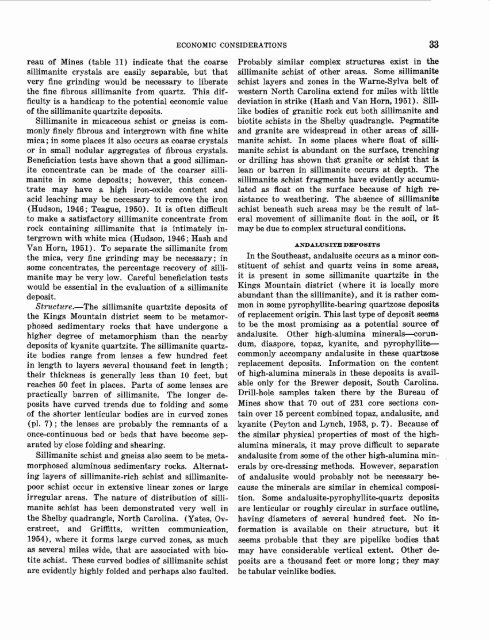Kyanite, Sillimanite, and Andalusite Deposits of the Southeastern ...
Kyanite, Sillimanite, and Andalusite Deposits of the Southeastern ...
Kyanite, Sillimanite, and Andalusite Deposits of the Southeastern ...
You also want an ePaper? Increase the reach of your titles
YUMPU automatically turns print PDFs into web optimized ePapers that Google loves.
ECONOMIC CONSIDERATIONS 33<br />
reau <strong>of</strong> Mines (table 11) indicate that <strong>the</strong> coarse<br />
sillimanite crystals are easily separable, but that<br />
very fine grinding would be necessary to liberate<br />
<strong>the</strong> fine fibrous sillimanite from quartz. This difficulty<br />
is a h<strong>and</strong>icap to <strong>the</strong> potential economic value<br />
<strong>of</strong> <strong>the</strong> sillimanite quartzite deposits.<br />
<strong>Sillimanite</strong> in micaceous schist or gneiss is commonly<br />
finely fibrous <strong>and</strong> intergrown with fine white<br />
mica; in some places it also occurs as coarse crystals<br />
or in small nodular aggregates <strong>of</strong> fibrous crystals.<br />
Beneficiation tests have shown that a good sillimanite<br />
concentrate can be made <strong>of</strong> <strong>the</strong> coarser sillimanite<br />
in some deposits; however, this concentrate<br />
may have a high iron-oxide content <strong>and</strong><br />
acid leaching may be necessary to remove <strong>the</strong> iron<br />
(Hudson, 1946; Teague, 1950). It is <strong>of</strong>ten difficult<br />
to make a satisfactory sillimanite concentrate from<br />
rock containing sillimanite that is intimately intergrown<br />
with white mica (Hudson, 1946; Hash <strong>and</strong><br />
Van Horn, 1951). To separate <strong>the</strong> sillimanite from<br />
<strong>the</strong> mica, very fine grinding may be necessary; in<br />
some concentrates, <strong>the</strong> percentage recovery <strong>of</strong> sillimanite<br />
may be very low. Careful beneficiation tests<br />
would be essential in <strong>the</strong> evaluation <strong>of</strong> a sillimanite<br />
deposit.<br />
Structure. The sillimanite quartzite deposits <strong>of</strong><br />
<strong>the</strong> Kings Mountain district seem to be metamorphosed<br />
sedimentary rocks that have undergone a<br />
higher degree <strong>of</strong> metamorphism than <strong>the</strong> nearby<br />
deposits <strong>of</strong> kyanite quartzite. The sillimanite quartzite<br />
bodies range from lenses a few hundred feet<br />
in length to layers several thous<strong>and</strong> feet in length;<br />
<strong>the</strong>ir thickness is generally less than 10 feet, but<br />
reaches 50 feet in places. Parts <strong>of</strong> some lenses are<br />
practically barren <strong>of</strong> sillimanite. The longer deposits<br />
have curved trends due to folding <strong>and</strong> some<br />
<strong>of</strong> <strong>the</strong> shorter lenticular bodies are in curved zones<br />
(pi. 7); <strong>the</strong> lenses are probably <strong>the</strong> remnants <strong>of</strong> a<br />
once-continuous bed or beds that have become separated<br />
by close folding <strong>and</strong> shearing.<br />
<strong>Sillimanite</strong> schist <strong>and</strong> gneiss also seem to be metamorphosed<br />
aluminous sedimentary rocks. Alternating<br />
layers <strong>of</strong> sillimanite-rich schist <strong>and</strong> sillimanitepoor<br />
schist occur in extensive linear zones or large<br />
irregular areas. The nature <strong>of</strong> distribution <strong>of</strong> sillimanite<br />
schist has been demonstrated very well in<br />
<strong>the</strong> Shelby quadrangle, North Carolina. (Yates, Overstreet,<br />
<strong>and</strong> Griffitts, written communication,<br />
1954), where it forms large curved zones, as much<br />
as several miles wide, that are associated with biotite<br />
schist. These curved bodies <strong>of</strong> sillimanite schist<br />
are evidently highly folded <strong>and</strong> perhaps also faulted.<br />
Probably similar complex structures exist in <strong>the</strong><br />
sillimanite schist <strong>of</strong> o<strong>the</strong>r areas. Some sillimanite<br />
schist layers <strong>and</strong> zones in <strong>the</strong> Warne-Sylva belt <strong>of</strong><br />
western North Carolina extend for miles with little<br />
deviation in strike (Hash <strong>and</strong> Van Horn, 1951). Silllike<br />
bodies <strong>of</strong> granitic rock cut both sillimanite <strong>and</strong><br />
biotite schists in <strong>the</strong> Shelby quadrangle. Pegmatite<br />
<strong>and</strong> granite are widespread in o<strong>the</strong>r areas <strong>of</strong> sillimanite<br />
schist. In some places where float <strong>of</strong> sillimanite<br />
schist is abundant on <strong>the</strong> surface, trenching<br />
or drilling has shown that granite or schist that is<br />
lean or barren in sillimanite occurs at depth. The<br />
sillimanite schist fragments have evidently accumulated<br />
as float on <strong>the</strong> surface because <strong>of</strong> high resistance<br />
to wea<strong>the</strong>ring. The absence <strong>of</strong> sillimanite<br />
schist beneath such areas may be <strong>the</strong> result <strong>of</strong> lateral<br />
movement <strong>of</strong> sillimanite float in <strong>the</strong> soil, or it<br />
may be due to complex structural conditions.<br />
ANDAL.USITE DEPOSITS<br />
In <strong>the</strong> Sou<strong>the</strong>ast, <strong>and</strong>alusite occurs as a minor constituent<br />
<strong>of</strong> schist <strong>and</strong> quartz veins in some areas,<br />
it is present in some sillimanite quartzite in <strong>the</strong><br />
Kings Mountain district (where it is locally more<br />
abundant than <strong>the</strong> sillimanite), <strong>and</strong> it is ra<strong>the</strong>r common<br />
in some pyrophyllite-bearing quartzose deposits<br />
<strong>of</strong> replacement origin. This last type <strong>of</strong> deposit seems<br />
to be <strong>the</strong> most promising as a potential source <strong>of</strong><br />
<strong>and</strong>alusite. O<strong>the</strong>r high-alumina minerals corundum,<br />
diaspore, topaz, kyanite, <strong>and</strong> pyrophyllite<br />
commonly accompany <strong>and</strong>alusite in <strong>the</strong>se quartzose<br />
replacement deposits. Information on <strong>the</strong> content<br />
<strong>of</strong> high-alumina minerals in <strong>the</strong>se deposits is available<br />
only for <strong>the</strong> Brewer deposit, South Carolina.<br />
Drill-hole samples taken <strong>the</strong>re by <strong>the</strong> Bureau <strong>of</strong><br />
Mines show that 70 out <strong>of</strong> 231 core sections contain<br />
over 15 percent combined topaz, <strong>and</strong>alusite, <strong>and</strong><br />
kyanite (Peyton <strong>and</strong> Lynch, 1953, p. 7). Because <strong>of</strong><br />
<strong>the</strong> similar physical properties <strong>of</strong> most <strong>of</strong> <strong>the</strong> highalumina<br />
minerals, it may prove difficult to separate<br />
<strong>and</strong>alusite from some <strong>of</strong> <strong>the</strong> o<strong>the</strong>r high-alumina minerals<br />
by ore-dressing methods. However, separation<br />
<strong>of</strong> <strong>and</strong>alusite would probably not be necessary because<br />
<strong>the</strong> minerals are similar in chemical composition.<br />
Some <strong>and</strong>alusite-pyrophyllite-quartz deposits<br />
are lenticular or roughly circular in surface outline,<br />
having diameters <strong>of</strong> several hundred feet. No information<br />
is available on <strong>the</strong>ir structure, but it<br />
seems probable that <strong>the</strong>y are pipelike bodies that<br />
may have considerable vertical extent. O<strong>the</strong>r deposits<br />
are a thous<strong>and</strong> feet or more long; <strong>the</strong>y may<br />
be tabular veinlike bodies.
















